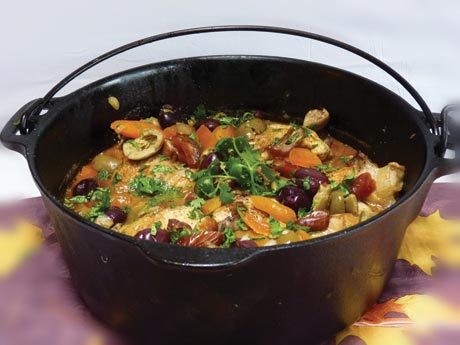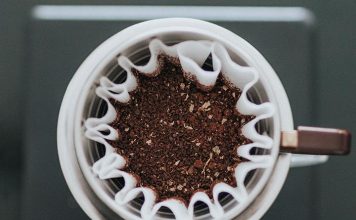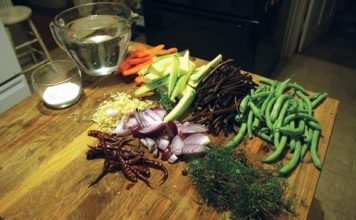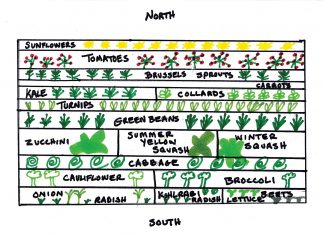 |
|
| Issue #129 • May/June, 2011 |
Last fall I was invited to Gold Beach, Oregon, to spend some quality time with my lifelong friend, Dave Duffy, and his family. On these visits it is customary for me to plan and prepare a meal for the Duffy family and any invited friends.
Over the years I’ve written, planned, and prepared dinner menus for a lot of folks while working in restaurants, hospitals, hotels, and other professional kitchens. However, cooking for friends and family has always given me the most satisfaction and pleasure. I use these meals to either introduce new recipes or present reworked versions of recipes from my existing files.
For this meal I reached back 16 years, to an article of mine published in the July/August 1995 issue of Backwoods Home Magazine. That article focused on the diversity, culinary appeal, and healthful benefits of foods served throughout the Mediterranean region.
Dave and his family have always enthusiastically embraced new foods, especially when they’re healthful and appealing. A tour of their pantry and long-term food-storage area revealed a variety of dried beans, rice, dates, figs, raisins, dried cranberries, nuts, green and black brine-cured olives, extra virgin olive oils, and several varieties of pasta I could choose from. Ingredients like these are used to prepare many popular entrées throughout the Mediterranean region and, since they were right here in front of me, I decided to try and work them into my menu plan. I had previously developed versions of several North African dishes that were not included in the 1995 Mediterranean article, and one or two of these recipes would be perfect for this meal.
Both of the dishes I prepared are popular throughout North Africa and, over the years, have become popular entrées in many high-end restaurants. The main entrée is a chicken dish traditionally prepared in a specialty cooker called a tagine. My version of this dish is made with apricots and marinated Greek olives. I also decided to make a couscous pilaf, but added a bit of New England character by including dried cranberries in place of the raisins, dates, or other dried fruit.
I also asked John Silveira to help develop a stuffed artichoke recipe that incorporated sausage for the appetizer.
After returning home to Connecticut, I also developed a vegetarian stuffing for artichokes. I have included it here as a great alternative to the sausage stuffing.
|
Stuffed artichokes
The artichoke is a perennial thistle with a foggy origin. The general opinion is that it originated somewhere in the Mediterranean region, with North Africa considered a strong possibility. The edible portions are the lower portions of the leaves closest to the inner base, known as the heart, and the heart itself. There is a hairy-looking mass sitting on top of the heart called the choke. These are immature flowerets and should be discarded.
|
When shopping, look for artichokes that are tightly packed. The leaves should be plump, and should snap, not tear, when bent back. Don’t be fooled into thinking that the small supermarket varieties, incorrectly labeled as babies, are something different. These are mature artichokes that grow in the shade of the plant’s leaves and don’t reach full size.
Artichokes require some trimming and steaming before stuffing. Steaming precooks the heart, allowing for the easy removal of the center leaves and the inedible choke. You can save time if you steam, wrap, trim, and refrigerate the artichokes the day before serving them. This will allow you to focus on the all-important stuffing the next day.
I use my water bath canning equipment to prepare five or more artichokes. For four or less, I use a collapsible steaming basket or a bamboo rack fit into a four-quart, heavy-bottom sauce pan with a tight-fitting lid.
Ingredients:
6 large or 8 medium fresh artichokes
3 cups panko-style bread crumbs
4 oz. fresh-grated Romano cheese, divided
2 tsp. extra virgin olive oil, divided
2 medium yellow onions, diced small
2 celery stalks, diced small
½ tsp. table salt
1½ lbs. bulk-pack Italian sausage (pork, chicken, or turkey)
5 cloves fresh garlic, minced
½ tsp. dried sage
¼ tsp. dried oregano
1 tsp. fresh thyme leaves, minced
½ tsp. fresh rosemary, minced
1½ cups low-sodium chicken broth
Preparing the artichokes:
1. Preheat the oven to 300º F.
2. Using a sharp knife, cut off the stem of each artichoke as close to the bottom as possible. With the same knife, cut off the top third of the artichoke and snip the top third of the remaining leaves with a pair of kitchen shears.
3. Sprinkle the prepared artichokes with salt and place them, stem side up, in the steaming apparatus. Cover and steam over medium-high heat for 35 to 40 minutes or until the inner leaves pull away from the heart easily.
4. Gently remove the artichokes with a pair of tongs and place them on a wire rack to cool for at least 30 minutes.
5. While the artichokes are cooling, spread the bread crumbs on a large rimmed cookie sheet and toast them in the oven, stirring occasionally, until they are a light, golden brown, about 15 minutes.
6. Transfer the toasted crumbs to a small bowl and stir in three ounces of the Romano cheese. Set this mixture aside.
7. Grab the center clump of leaves and remove them from each artichoke. This will expose the hairy clump at the bottom called the choke. Carefully scoop out the choke with a spoon to expose the heart at the bottom.
8. If the cavity created by removing the center leaves is not large enough to hold the amount of stuffing that you plan to use, you can remove additional leaves from the center to make it larger.
9. Cover the cooled artichokes with plastic wrap and set them aside while preparing the stuffing.
Preparing the sausage stuffing:
1. Increase the oven heat to 375º F.
2. Heat one teaspoon of olive oil in a 12-inch skillet, over medium heat, until it starts to ripple.
3. Add the onions, celery, and ½ teaspoon of table salt and cook, stirring frequently, until the vegetables are soft but not brown. Reduce the heat if they start to scorch.
4. Increase the heat to medium-high and add the sausage. Cook the sausage, stirring frequently to break up any large clumps. Continue cooking until the sausage loses its pink color and starts to brown.
5. Add the garlic, sage, oregano, thyme, and rosemary and cook, stirring constantly, until fragrant, about 30 seconds.
6. Remove from the heat and blend the bread crumbs and cheese with the sausage mixture.
7. Slowly stir in the chicken broth until the stuffing reaches a moist, but not soggy consistency. You can match the consistency of this with your preference for a poultry stuffing. My wife, Tricia, likes a moist stuffing similar to the type that is cooked inside a turkey. The rest of the family likes their stuffing a little drier like stuffing cooked in an uncovered casserole.
8. Spoon the desired amount of stuffing into each artichoke and sprinkle the remaining cheese on top.
9. Place the stuffed artichokes on a rimmed baking sheet, lightly cover them with a piece of aluminum foil, and bake for about 30 minutes.
10. Remove the aluminum foil and continue baking for an additional 15 minutes or until the internal temperature of each artichoke reaches 150º F when measured with a food thermometer. Serve immediately.
|
Curried lentil, mushroom, and rice stuffing for stuffed artichokes
My son Michael is a vegetarian. So whenever I plan a meat-based meal, at home or away, I plan on a meatless alternative that is both nutritionally adequate and satisfying. It wasn’t necessary to prepare this recipe in Oregon. I did, however, prepare and serve it at a recent family meal to get some feedback from my review committee. All the comments were favorable, so I am including it here as an extra feature.
Ingredients:
4 medium artichokes
10 oz. frozen chopped kale or spinach, thawed
1 cup cooked jasmine or basmati rice
½ cup brown lentils
2 cups vegetable broth
2 Tbsp. extra virgin olive oil
1 medium yellow onion, diced
8 oz. white mushrooms, diced
1 small jalapeño pepper, seeds and stems removed, minced (optional)
2 medium cloves fresh garlic, minced
1 tsp. fresh ginger, minced
1 tsp. mild curry powder
¼ cup dry sherry
2 oz. crumbled Romano cheese
2 Tbsp. cilantro leaves, chopped
½ tsp. lemon zest
¼ cup chopped cashews or walnuts
salt and fresh ground pepper to taste
Method:
1. Trim and steam the artichokes as described in the previous recipe.
2. Preheat the oven to 375º F.
3. Place the thawed kale or spinach in a mesh strainer and squeeze out as much liquid as possible.
4. If you don’t have any leftover rice in the refrigerator, cook ½ cup of jasmine or basmati rice, following the directions on the package. This will make one cup of cooked rice. Set the cooked rice aside to cool.
5. Combine the lentils and vegetable broth. Bring the mixture to a boil over medium-high heat, then reduce the heat and simmer the lentils for 30 minutes, or until they are tender but still retaining their shape. Drain the lentils and save the remaining broth. You will need at least ¼ cup.
6. Add two tablespoons of oil to a 10-inch heavy-bottom sauté pan. Set the pan over medium heat. When the oil starts to ripple, add the onion and cook, stirring frequently until they begin to soften.
7. Add the mushrooms and continue cooking the mixture until they begin to soften, about five minutes.
8. Add the jalapeño pepper, garlic, ginger, and curry powder and cook until fragrant, about 30 seconds.
9. Add the sherry and continue cooking, stirring constantly, until the sherry is reduced and the pan is almost dry.
10. Stir in the ¼ cup of reserved broth and remove the pan from the heat. Gently fold in the cooked lentils, rice, Romano cheese, cilantro, and lemon zest. Season the mixture, to taste, with salt and fresh ground black pepper.
11. Stuff and bake the artichokes as described in the previous recipe and sprinkle the chopped nuts on top.
This will serve four people.
|
Marinated olives
Olives of all kinds can be found throughout the Mediterranean. Greeks seem to have more varieties than anyone else. Fortunately for us in this country, olive bars featuring high-quality olives, both imported and domestic, and cured both in brine and in oil, have become the latest rage in supermarkets.
I learned how to brine-cure olives many years ago from one of the most knowledgeable Italian cooks I’ve ever known. Mrs. Troiano was one of the many watchful mothers that checked the progress of my daily walk to and from school. In her backyard were two massive grape vines. The grapes from these vines were processed into bottles of homemade red wine which was served at most family meals. She also cured her own green and black olives every year.
Every Christmas she gave my mother two pint-jars of olives. One contained olives that were cured in basic salt brine, the second contained black and green olives marinated in spiced olive oil and Sambuca, an anise-flavored Italian liqueur.
These olives never lasted very long in our house. My mother served them on salads, as appetizers, or simply as snacks.
I now keep a jar of marinated olives in the refrigerator year-round, and use them in many of my recipes, including those for soups, salads, and many entrées. I prefer marinated olives I cure myself, but it takes about six weeks to properly cure a batch.
But whenever I discover I’m out of home-cured olives, I buy them at my local supermarket.
I included Mrs. Troiano’s formula for home-curing olives in the Jan/Feb 1997 issue of Backwoods Home Magazine. If you decide to cure your own olives, raw olives can be found in some supermarkets, sold by the pound.
Ingredients:
1 tsp. whole cumin seed
1 tsp. whole coriander seed
½ tsp. whole fennel seed
3 medium shallots, peeled and sliced thin
4 cloves fresh garlic, peeled and sliced thin
6 scallions (green onions), both the white and green parts, sliced thin
1 tsp. fresh rosemary leaves, coarsely chopped
2 tsp. grated zest from one lemon
1 tsp. fresh lemon juice
1 tsp. red pepper flakes
½ tsp. kosher salt
3 Tbsp. Sambuca
½ cup extra virgin olive oil
1 cup whole, brine-cured green olives
1 cup whole, brine-cured black olives
Method:
1. Toast the cumin, coriander, and fennel seed in a ten-inch heavy-bottom sauté or frying pan until golden brown. Transfer the toasted seeds to a heat-resistant bowl and set aside.
2. Prepare and combine the shallots, garlic, scallions, rosemary leaves, and lemon zest and set them aside in a medium size nonreactive (glass, plastic, or stainless steel) bowl.
3. Add the lemon juice, pepper flakes, salt, Sambuca, and olive oil along with the cooled whole spices and blend.
4. Add the olives and transfer the mixture to a Mason jar or plastic container with a tight-fitting lid.
5. Place the container in the refrigerator and marinate the olives for at least 24 to 48 hours.
I suggest using the olives within a week of preparation.
|
Braised Moroccan chicken with marinated olives
Ingredients:
6 cloves fresh garlic, about 4 tsp., minced
4 lemon zest strips, two inches long and about one inch wide (see sidebar for making lemon zest strips)
¼ tsp. cayenne pepper
2 tsp. Hungarian sweet paprika
½ tsp. fresh ground black pepper
1 tsp. ground cumin
½ tsp. ground coriander
1 tsp. ground ginger
¼ tsp. ground fennel seed
2 lbs. bone-in, skin-on chicken thighs
2 lbs. bone-in, skin-on chicken legs
salt and fresh ground black pepper
½ cup unbleached all-purpose flour
2 Tbsp. vegetable oil
2 medium yellow onions, skins removed, cut in half pole to pole, and sliced ¼ inch thick
½ cup dry white wine
3 medium carrots, peeled and cut into ½-inch-thick coins
1½ cups low sodium chicken broth
½ cup dried apricots, cut in half
½ cup pitted dates, cut in half
1 cup marinated Greek olives, cracked and pitted
¼ cup fresh cilantro leaves, minced
Method:
1. Prepare the garlic and lemon zest as directed. Set them aside in separate containers.
2. Combine the next seven ingredients in a small bowl along with half of the minced garlic and one lemon zest strip, minced. Set this mixture aside.
3. Dry the chicken pieces with paper towels and sprinkle lightly with salt and pepper.
4. Dredge the chicken pieces in the flour, shake off the excess, and place the pieces on a wire rack set inside a rimmed baking sheet.
5. Add two tablespoons of vegetable oil to a large Dutch oven set over medium-high heat. When it starts to ripple, place half of the chicken in the pot and brown on all sides. Reduce the heat if the chicken starts to burn. Set the browned pieces aside on the rimmed baking sheet. Return the pot to the heat, add additional oil if necessary and brown the remaining chicken and set it aside on the baking sheet, too.
6. Remove all but one tablespoon of oil from the pot. Return the pot to the burner set at medium-high.
7. Add the onions and the remaining three lemon zest strips. Cook until the onions soften.
8. Add the spice mixture to the onions and cook until fragrant, about 30 seconds.
9. Stir in the wine and cook until it is almost completely evaporated.
10. Add the carrots and broth. Scrape the bottom of the pot to remove any browned bits.
11. Add the chicken along with any accumulated juices back to the pot. Bring the mixture to a simmer, cover and cook over medium-low heat until the carrots are tender and the internal temperature of the chicken is at least 160º F. This will take about 45 to 60 minutes.
12. Transfer the chicken to a platter and cover with a piece of aluminum foil.
13. Skim as much fat as possible from the surface of the sauce as you can. Add the dried apricots and dates. Return the sauce to a simmer until it thickens a little, about 10 minutes.
14. Return the chicken pieces to the pot along with garlic/lemon zest mixture, cilantro, and marinated olives. Simmer for an additional two or three minutes to heat all the ingredients. Adjust the seasoning with salt and fresh ground black pepper to taste.
|
Couscous pilaf
Mention North Africa to any food lover and chances are that couscous will be one of the foods that will come to his or her mind. This small grain pasta is without a doubt the most famous food of the North African region. Couscous is often referred to as a Moroccan dish, but folks in Algeria, Tunisia, Egypt, Libya, and Israel also claim that their countries are the official home of couscous.
This recipe has been a regular item at my dinner table since I wrote the Mediterranean article in 1995. Unfortunately, I didn’t include it then, but since it has become so popular with my family and neighbors, I decided to share it with everyone.
Substituting dried cranberries for the traditional raisins, currants, or dates is my wife Tricia’s idea. They add brightness to this dish that is reminiscent of many traditional New England dishes we grew up eating. There are hundreds of methods used throughout North Africa to prepare couscous. In Tunisia couscous dishes are usually hot and spicy containing fiery chili pepper seasonings along with coriander, cumin, and garlic.
This recipe produces a couscous that is exotic, mellow, and moist, as found in Morocco and Algeria. If you would like to spice up this recipe, simply add 1 teaspoon of cumin, ½ teaspoon of cayenne pepper, and ¼ teaspoon of ground cinnamon to the pan when you add the garlic. For best results, this recipe calls for a high-quality fine-grain couscous which is sold in many high-end supermarkets or specialty markets that feature Mediterranean and North African foods.
Ingredients:
2 Tbsp. unsalted butter
2 cups fine-grained whole wheat or regular couscous
2 Tbsp. extra virgin olive oil
1 medium yellow onion, diced small
1 medium shallot, sliced thin
2 cloves fresh garlic, minced
½ cup dried, sweetened cranberries
2 cups low-sodium vegetable or chicken broth
1¾ cups water
1 tsp. fresh lemon juice
½ cup walnuts, roughly chopped and lightly toasted
Method:
1. Melt the butter in a 12-inch heavy-bottom skillet set over medium-high heat.
2. When it stops foaming, add the couscous and cook, stirring frequently, until the individual grains begin to turn a light brown. This will take about three minutes.
3. Transfer the browned couscous to a two or three-quart casserole with a tight-fitting lid, and return the pan to the heat.
4. Add the olive oil to the skillet. When the oil starts to ripple, add the onion and shallot. Cook, stirring frequently, until the onion begins to brown in about five minutes.
5. Add the garlic and cook, stirring constantly, until it becomes fragrant in about 30 seconds.
6. Add the cranberries, vegetable or chicken broth, and water. Increase the heat to high and bring the mixture to a boil.
7. Add the hot broth to the casserole with the toasted couscous, cover tightly with plastic wrap and the casserole’s cover. Allow the couscous to sit for at least 15 minutes. Remove the casserole lid and the plastic wrap, gently stir in the lemon juice. Garnish the surface with the walnuts. Serve immediately.
Preparing this meal was a wonderful and uplifting experience for me. I am always at my best when cooking for friends and family. Especially when they are willing to pitch in and help like these folks did. I am looking forward to doing this again soon.




















